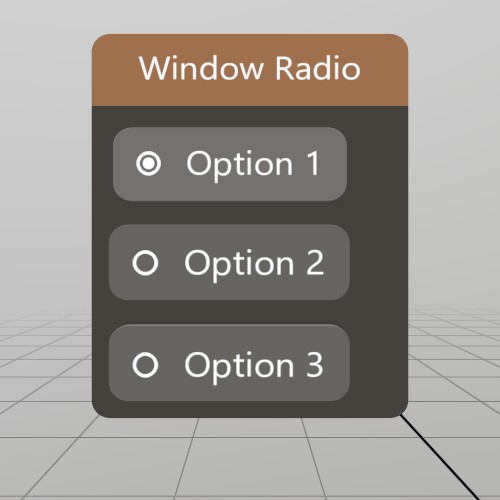UI.Radio
static bool Radio(string text, bool active)
A Radio is similar to a button, except you can specify if it looks pressed or not regardless of interaction. This can be useful for radio-like behavior! Check an enum for a value, and use that as the ‘active’ state, Then switch to that enum value if Radio returns true.
| string text | Text to display on the Radio and id for tracking element state. MUST be unique within current hierarchy. |
| bool active | Does this button look like it’s pressed? |
| RETURNS: bool | Will return true only on the first frame it is pressed! |
static bool Radio(string text, bool active, Vec2 size)
A Radio is similar to a button, except you can specify if it looks pressed or not regardless of interaction. This can be useful for radio-like behavior! Check an enum for a value, and use that as the ‘active’ state, Then switch to that enum value if Radio returns true.
| string text | Text to display on the Radio and id for tracking element state. MUST be unique within current hierarchy. |
| bool active | Does this button look like it’s pressed? |
| Vec2 size | The layout size for this element in Hierarchy space. If an axis is left as zero, it will be auto-calculated. For X this is the remaining width of the current layout, and for Y this is UI.LineHeight. |
| RETURNS: bool | Will return true only on the first frame it is pressed! |
static bool Radio(string text, bool active, Sprite imageOff, Sprite imageOn, UIBtnLayout imageLayout)
A Radio is similar to a button, except you can specify if it looks pressed or not regardless of interaction. This can be useful for radio-like behavior! Check an enum for a value, and use that as the ‘active’ state, Then switch to that enum value if Radio returns true. This version allows you to override the images used by the Radio.
| string text | Text to display on the Radio and id for tracking element state. MUST be unique within current hierarchy. |
| bool active | Does this button look like it’s pressed? |
| Sprite imageOff | Image to use when the radio value is false. |
| Sprite imageOn | Image to use when the radio value is true. |
| UIBtnLayout imageLayout | This enum specifies how the text and image should be laid out on the radio. For example, UIBtnLayout.Left will have the image on the left, and text on the right. |
| RETURNS: bool | Will return true only on the first frame it is pressed! |
static bool Radio(string text, bool active, Sprite imageOff, Sprite imageOn, UIBtnLayout imageLayout, Vec2 size)
A Radio is similar to a button, except you can specify if it looks pressed or not regardless of interaction. This can be useful for radio-like behavior! Check an enum for a value, and use that as the ‘active’ state, Then switch to that enum value if Radio returns true. This version allows you to override the images used by the Radio.
| string text | Text to display on the Radio and id for tracking element state. MUST be unique within current hierarchy. |
| bool active | Does this button look like it’s pressed? |
| Sprite imageOff | Image to use when the radio value is false. |
| Sprite imageOn | Image to use when the radio value is true. |
| UIBtnLayout imageLayout | This enum specifies how the text and image should be laid out on the radio. For example, UIBtnLayout.Left will have the image on the left, and text on the right. |
| Vec2 size | The layout size for this element in Hierarchy space. If an axis is left as zero, it will be auto-calculated. For X this is the remaining width of the current layout, and for Y this is UI.LineHeight. |
| RETURNS: bool | Will return true only on the first frame it is pressed! |
Examples
Radio button group

Radio buttons are a variety of Toggle button that behaves in a manner more conducive to radio group style behavior. This is an example of how to implement a small radio button group.
Pose windowPoseRadio = new Pose(1.5f, 0, 0, Quat.Identity);
int radioState = 1;
void ShowWindowRadio()
{
UI.WindowBegin("Window Radio", ref windowPoseRadio);
if (UI.Radio("Option 1", radioState == 1)) radioState = 1;
if (UI.Radio("Option 2", radioState == 2)) radioState = 2;
if (UI.Radio("Option 3", radioState == 3)) radioState = 3;
UI.WindowEnd();
}
Found an issue with these docs, or have some additional questions? Create an Issue on Github!
